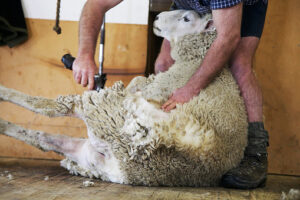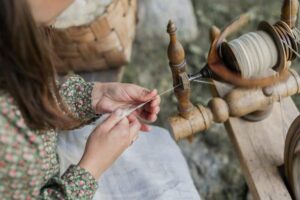Yarn is the first step to making a beautiful piece of fabric. It can be made from both natural fibers and synthetic fibers.
What is yarn? Well, yarn is a continuous length of interlocked fibers. The fibers are twisted together from the spinning process. The type of twist also determines the quality and the texture of the yarn.
The fibers of different materials like cotton, wool, silk, and many more are interlocked together by machine or hand to form a strong bond. Depending on the materials used we can find different types of yarn.
In this blog, we are specifically going to talk about yarn made from wool. We are going to know about the steps that go into the process of turning the wool from the sheep into a colorful yarn that is later turned into clothes that we wear.
 The person who is shearing the sheep is trained to do so. They try to remove all the sheep’s fleece in one piece without hurting the sheep. Shearing also prepares the sheep for the warmer seasons. The thin coat allows the sheep to stay cool during the summer season.
Shearing plays an important role in the health of the sheep. It is very beneficial for the sheep.
The person who is shearing the sheep is trained to do so. They try to remove all the sheep’s fleece in one piece without hurting the sheep. Shearing also prepares the sheep for the warmer seasons. The thin coat allows the sheep to stay cool during the summer season.
Shearing plays an important role in the health of the sheep. It is very beneficial for the sheep.
 In many big factories, different motor-operated machines are used that run on electricity or battery. They are designed to spin a large amount of wool in a short time.
To sum up, the whole process of making the wool is a few steps that might take some time. The art of turning wool into yarn has been since ancient times and is still being done. The yarn from the wool can be used for making different things. Wool is one of the most versatile materials
In many big factories, different motor-operated machines are used that run on electricity or battery. They are designed to spin a large amount of wool in a short time.
To sum up, the whole process of making the wool is a few steps that might take some time. The art of turning wool into yarn has been since ancient times and is still being done. The yarn from the wool can be used for making different things. Wool is one of the most versatile materials
Process of Turning Wool into Yarn
We all know that most of the wool is obtained from sheep. So the first process of turning wool into yarn is obtaining the wool. Then the obtained wool is further cleaned and processed to form a beautiful yarn.Shearing the Sheep
Every year the coat of the sheep is sheared using a mechanical razor machine. The machine is specially designed for shearing the sheep. The person who is shearing the sheep is trained to do so. They try to remove all the sheep’s fleece in one piece without hurting the sheep. Shearing also prepares the sheep for the warmer seasons. The thin coat allows the sheep to stay cool during the summer season.
Shearing plays an important role in the health of the sheep. It is very beneficial for the sheep.
The person who is shearing the sheep is trained to do so. They try to remove all the sheep’s fleece in one piece without hurting the sheep. Shearing also prepares the sheep for the warmer seasons. The thin coat allows the sheep to stay cool during the summer season.
Shearing plays an important role in the health of the sheep. It is very beneficial for the sheep.
Also read: The Real Benefits of Sheep Shearing.The sheared wool is then sorted based on the quality of the wool and prepared for cleaning.
Cleaning the Wool
The shorn wool is usually dirty. It contains vegetable matter, dirt, manure, and natural oil called Lanolin. These elements must be removed before continuing with further processing The wool is cleaned using mild detergent and water or sometimes they are submerged in the acidic water to dissolve all the natural oils and the vegetable matter. When cleaning the wool it is crucial to not use hot water. As there is a high chance of shrinking the material and felting it. The cleaner does not use excessive motion when cleaning the wool. A byproduct obtained from wool is also sometimes used for different purposes. Like the natural oil is collected and turned into wax which is kept in cosmetic products like moisturizers. The waste wool which cannot be turned into yarn is used as a mulch for vegetables.Carding the Wool
Carding is an important step in turning wool into yarn. Usually, the wool is in matted form after washing and some residue still gets left in the wool. So it is necessary to remove the tangles and matt from the wool for smooth yarn. So, the wool is carded to smooth out the matted wool and remove the dirt and residue left in the wool. A pair of hand carders that resemble a dog hairbrush is used to card the wool. The wools are combed through the brush until the wool is aligned in the same direction. a large amount of wool is carded in a carding drum which can card wool in large amounts and in minimum time. Carding also makes the fiber light and fluffy which makes it ready to be spun into yarn.Dyeing Process
Dyeing the wool is not a complicated job and it can be done before or even after turning the wool into yarn. No harmful chemicalized dye is used to color the wool. Natural colors are usually used for dyeing wool. It is safe for the environment and for humans as well. The plants that are normally used to extract the color for the wool dyeing process are acorn and dandelions for the brown shade, marigolds, and sunflower for yellow, hibiscus, and blueberries for purple, and many more. So, there is a wide variety of plants that you can use to make the natural dye.Spinning the Wool
Now comes the most crucial step of turning the wool into yarn. After the wool is cleaned and carded it is spun into a yarn. Usually, there are two types of equipment used for spinning wool manually. They are spinning wheel and drop spindle. The spinning wheel is faster compared to the drop spindle but for beginners drop spindle is great. In many big factories, different motor-operated machines are used that run on electricity or battery. They are designed to spin a large amount of wool in a short time.
To sum up, the whole process of making the wool is a few steps that might take some time. The art of turning wool into yarn has been since ancient times and is still being done. The yarn from the wool can be used for making different things. Wool is one of the most versatile materials
In many big factories, different motor-operated machines are used that run on electricity or battery. They are designed to spin a large amount of wool in a short time.
To sum up, the whole process of making the wool is a few steps that might take some time. The art of turning wool into yarn has been since ancient times and is still being done. The yarn from the wool can be used for making different things. Wool is one of the most versatile materials
